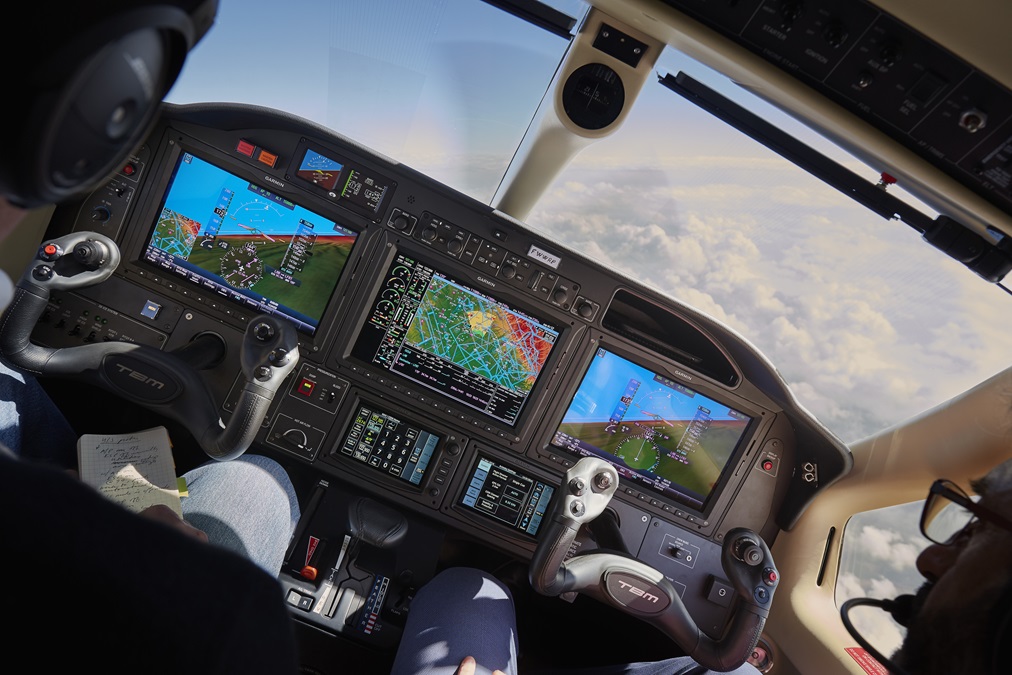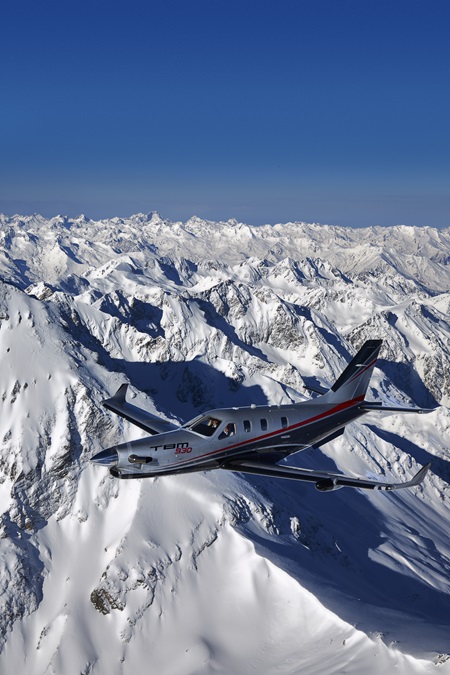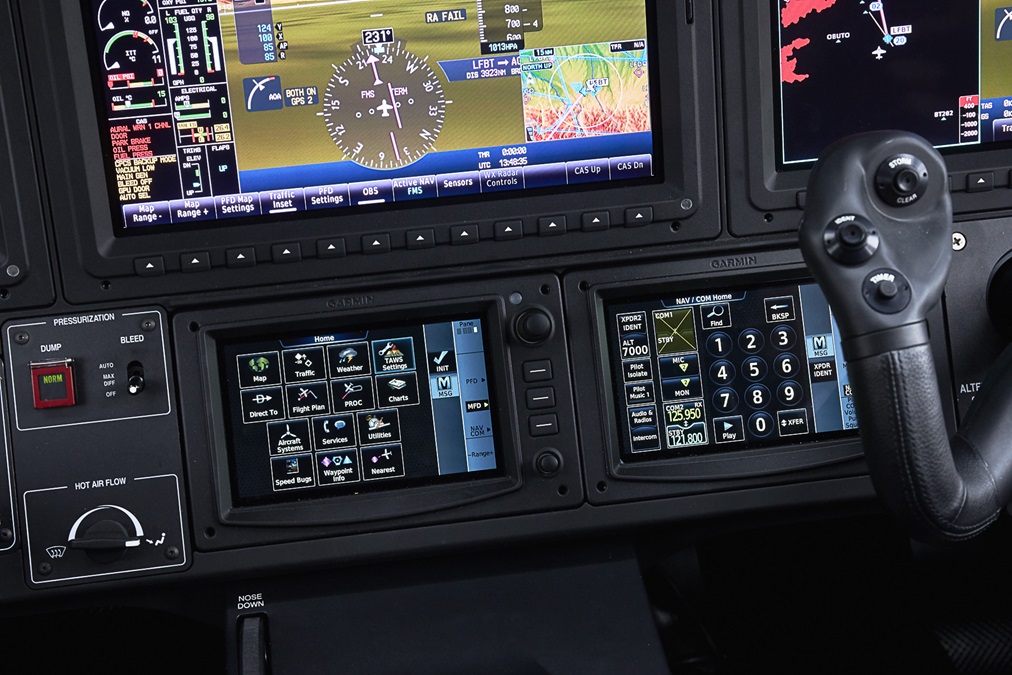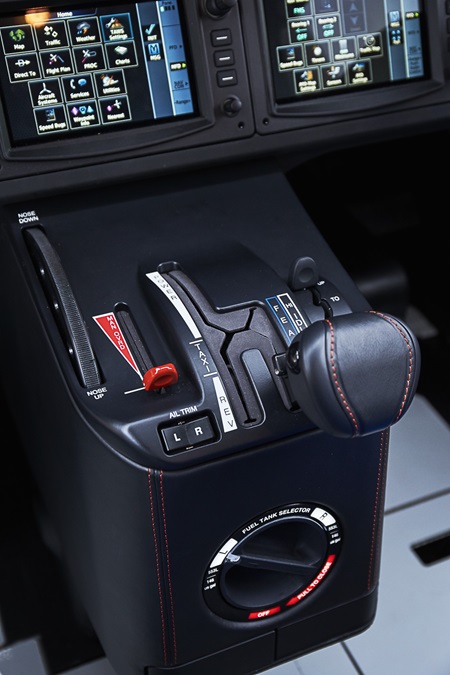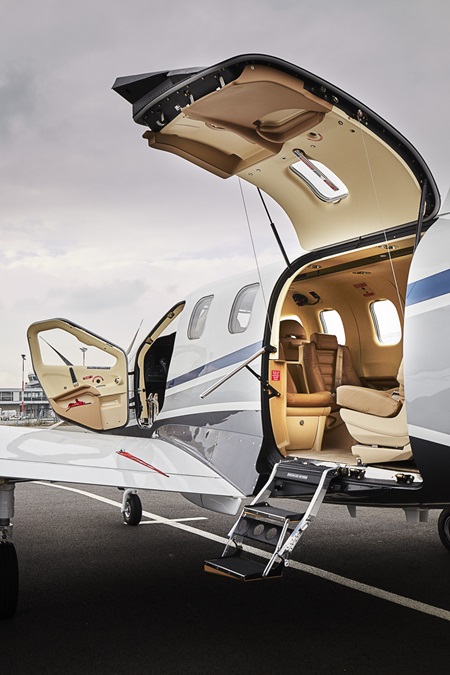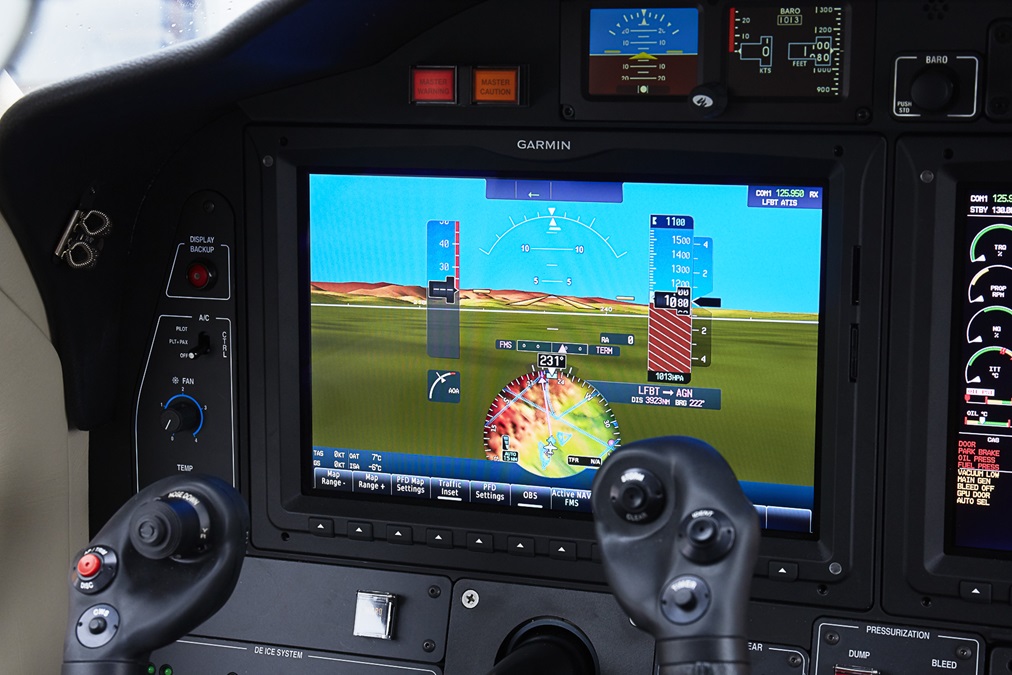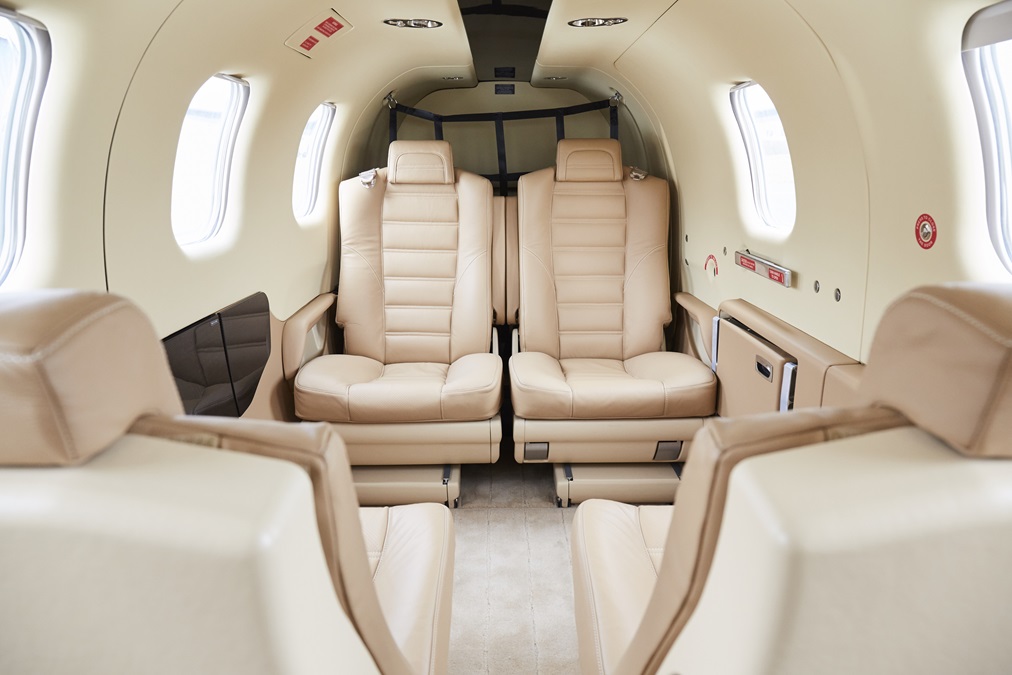TBM's 930 Joins The Flock
A safety step-up for the ultimate personal turboprop
The TBM 700 was an immediate hit, racking up 26 sales in its first year of production (among the first buyers were auto racing legend and warbird collector Robert Pond, and singer Jimmy Buffett). After that came the inevitable upgrades to the basic design: a large aft door, a gross weight increase, a pilot door. In 2006 came the TBM 850 and a boost in the Pratt & Whitney PT6A’s power from 700 to 850 shaft horsepower. In 2008 Garmin’s G1000 became standard. And in 2014 an ambitious aerodynamic cleanup gave us the TBM 900, with a 330-knot maximum cruise speed.
New for 2016
The latest big news is the TBM 930, introduced in April. This model has the same performance specifications as the TBM 900, but comes with Garmin’s G3000 avionics suite, manipulated by dual Garmin GTC 580 touchscreen controllers. Also included is electronic stability protection, a feature that automatically keeps the airplane’s attitude and airspeed safely within the flight envelope. An angle of attack sensor and thumbnail primary flight display (PFD) are additional firsts for the TBM design, as is an emergency descent management (EDM) feature.
Yet another big safety item is a beefed-up, transport-style aural warning system. This uses voice commands instead of the previous horns, chimes, and tones to alert unsafe conditions. Where once you heard a simple stall horn, now you hear an “airspeed, airspeed” callout as airspeed drops to critical levels, and then “stall, stall” as the airplane approaches the threshold of a stall. That, and a stick shaker goes off.
G3000 and GTC 580
The G3000—which also is used in Cessna’s Citation CJ3+ and M2, Cirrus’ Vision SF50, Embraer’s Phenom 300, Piper’s M600, and the HondaJet—brings new levels of capability to the TBM line. It comprises three high-definition, 12-inch-diagonal-display screens. The GTC 580s are used to call up various display options. Three line select keys let you select the menu shortcut icons for PFD, MFD, and nav/com views. Press the PFD key and bearing pointers and course deviation indicator (CDI) depictions can be selected, along with many more options. You can even change the inset map display to appear within the CDI’s compass rose.
Press the MFD key and the GTC 580 shows the multifunction display’s many homepage icons: Map, Traffic, Wx, TAWS, Direct, Flight Plan, Procedures, Chart Selection, Aircraft Systems, Services, Utilities, Speed Bugs, Waypoint information, and Nearest. Tap on one of these icons and submenus pop up to let you choose your view. After that, there are many layers of additional information or control to choose from. It takes some learning, so if you’re like me, you’ll be hitting the Back icon a lot while getting the hang of the suite.
The G3000 can display Jeppesen’s ChartView or Garmin’s FliteCharts electronic charts, so tap Chart Selection, and then pick your chart—say, an approach chart. Once you do this, a scratchpad appears on the lower portion of the 580. Now you can use your fingers to pinch the chart display to a larger or smaller size, or drag it around the display to get a close-up view of any chart details.
A Full or Split icon lets you choose between having the three main screens, or splitting each one in two—giving you the use of six different screen views. A rotary knob at the top of the 580 is there to let you choose among the available panes. Want the approach chart next to the captain’s PFD? Then rotate the knob so that the second-to-left pane is highlighted. In this way, you can show six different sources of information at once. That’s an impressive amount of situational awareness.
The TBM 900—which is being offered concurrently—still has the G1000 and its keypad-driven, three-screen display setup. This gives customers a choice between “old-school” push-and-turn, chapter-and-page G1000 operating logic and the G3000’s icon-driven, layered menu operations.
EDM, ESP, and Shaker
To get a taste of the ESP and EDM capabilities, we visited the TBM factory in Tarbes, France, in March. We flew with Daher-Socata’s Flight Test Chief Pilot Stephane Jacques. First came all the usual preflight checks, including a look at the GTC 580’s MFD controls, to make sure the ESP key is active (you can disengage it by turning off the ESP key, or pressing the control yoke’s red Control Wheel Steering button).
After takeoff, we climbed to 20,000 feet, leveled off, set cruise power—and shut off the bleed air to the cabin. Two things happened. First, we donned our oxygen masks as a precaution. Second, the cabin altitude began to climb at approximately 1,000 fpm. As the cabin altitude hit 10,000 feet, on came the “use oxygen mask” voice callout. The EDM trigger limit is a cabin altitude of 14,900 feet, and when the cabin got there we made no inputs, simulating a pilot-incapacitation scenario. On came the EDM mode, displayed by a red “EDM” message at the top of the PFD’s airspeed tape. The airplane turned 90 degrees to the left, then began a descent at 265 knots, which yielded a 3,800-fpm descent rate. Soon we were at 15,000 feet—the level-off floor of the EDM maneuver. Why 15,000 feet? To prevent a descent into high terrain.
EDM, which is used in other sophisticated airplanes, presumably was added as part of a response to the 2014 fatal accident involving TBM Owners and Pilots Association President Larry Glazer and his wife, Jane. Another response was a program of altitude chamber testing for TBM pilots, conducted at Melbourne, Florida’s Southern AeroMedical Institute (“Slow-Onset Survival,” April 2016 Turbine Pilot). It’s thought that Glazer succumbed to hypoxia during a flight from Rochester, New York, to Naples, Florida. His TBM 900 flew to fuel exhaustion and crashed off Jamaica.
The ESP system uses inputs from the airplane’s attitude and heading reference system (AHRS), together with its AOA, to talk to the TBM 930’s GFC 710 autopilot servos. Exceed any pitch, roll, or airspeed limits and the servos will apply forces to keep the airplane within the defined flight envelope. Nose-up pitch limits are plus 20 degrees; nose-down limits are minus 22 degrees; and roll limits are 45 degrees. Come up against these limits and you’ll be fighting the servos. The more you fight, the stronger the system’s counterforce. And if the auto-pilot was disengaged during all this, it will automatically engage with an aural “autopilot” callout after 10 seconds of fighting within a 20-second time frame. At this point the autopilot will automatically switch to a wings-level, zero-vertical-speed mode.
Underspeed protection kicks in when the autopilot is on, in order to prevent the type of stall that could come about after leveling off from a descent and failing to add sufficient power. As airspeed drops, the “airspeed, airspeed” and then “stall, stall” callouts will kick in. The servos begin to nose over when airspeed trend vectors reach anywhere from 88 knots (no flaps) to 74 knots (landing flaps). At the same time a pitch limit indicator symbol appears above the PFD’s aircraft reference symbol.
Topping things off are plans for a stick shaker, which should be installed in all new TBM 930s and 900s by the time you read this. Stick shakers vibrate the control yoke when the airplane is slowed to an airspeed just above the stall. With the airspeed and stall warnings blaring, the stick shaker is the icing on the cake. It would be extremely difficult for a pilot to overlook all these warnings.
Retrofits
Daher isn’t forgetting about the owners of in-service TBMs, including the 700 and 850. Retrofit ESP and AOA packages were in development for in-service TBM 900s at the time this article went to press, according to Daher officials. The aural-warning package will be made available free of charge to owners of all 400 or so G1000-equipped airplanes in service, and stick shakers will be a paid retrofit for those airplanes as well. Retrofit AOA systems for the TBMs 700 and 850 are being studied.
There’s more
There are additional improvements. TBM 930s will come with L-3 voice and data recorders. There’s a new Mid-Continent MD302 standby instrument system with a self-contained battery and a new Garmin GRA 55 radar altimeter. Garmin’s Flight Stream 210 will allow Bluetooth connectivity so that Garmin Pilot- and ForeFlight-equipped iPads can stream flight plans, GPS, and ADS-B In weather and traffic information to and from the cockpit.
The 930 comes with redesigned seats, too. The side bolsters are deeper and provide more lateral support to the occupants, and the front seats seem to be a tad narrower. Those seats come in your choice of eight colors, but for an extra $5,000 you can pick from 32 more leather colors. The Diamond Black leather seats, with their red stitching, seem especially popular.
The TBM 930 lists for $4,099,277. The TBM 900 comes in at $3,889,626.
Last—but certainly not least, especially for those in need—there’s a rumor going around about an enclosed aft lav. Daher could spill the beans on that at EAA AirVenture 2016. And for you planespotters out there: How do you tell the difference between a TBM 900 and a TBM 930? The 930’s fuselage accent stripe is curved; the 900’s is straight.
With the TBM 930, Daher has taken an already capable, apex personal turboprop single and transformed it into a safer machine with big-airplane safety systems. And am I alone in sensing a another firm nod in the direction of fly-by-wire technology to come?
Email [email protected]
SPEC SHEET
Daher-Socata TBM 930
Standard price: $4,099,277
Specifications
Powerplant | Pratt & Whitney Canada PT6A-66D, 850 shp
Length | 35.22 ft
Height | 14.29 ft
Wingspan | 42 ft
Wing loading | 38.2 lb/sq ft
Power loading | 8.7 lb/shp
Seats | 6
Basic empty weight | 4,629 lb
Max ramp weight | 7,430 lb
Max takeoff weight | 7,394 lb
Max payload | 1,403 lb
Max payload w/full fuel | 891 lb
Fuel capacity | 291 gal (1,950 lb)
Max luggage w/six seats | 330 lb
Performance
Takeoff distance | 2,380 ft
Max cruise speed at long-range power | 252 KTAS
Max cruise speed, 28,000 ft | 330 KTAS
Time to climb to 31,000 ft | 18 min 45 sec
Max operating altitude | 31,000 ft
Sea-level cabin | 14,390 ft
Landing distance | 2,430 ft
Max range with one pilot and w/45-min reserve @31,000 ft:
@252 KTAS | 1,730 nm
@290 KTAS | 1,585 nm
@326 KTAS | 1,440 nm
Limiting and recommended airspeeds
VX (best angle of climb) | 100 KIAS
VY (best rate of climb) | 124 KIAS
VA (design maneuvering) | 160 KIAS
VMO (max operating speed) | 266 KIAS
VS0 (stall, in landing configuration) | 65 KIAS
All specifications are based on manufacturer’s calculations. All performance figures are based on standard day, standard atmosphere, maximum weight conditions unless otherwise noted. For more information, visit the manufacturer’s website.
Extra
Even with the new cockpit hardware, Daher says that the TBM 930 weighs within 10 pounds of its TBM 900 predecessor.

